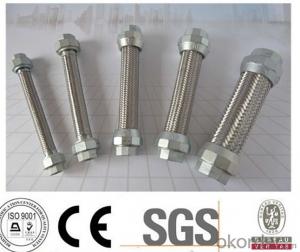Stainless Steel Braid Hose with Special Treatment
- Loading Port:
- Tianjin
- Payment Terms:
- TT OR LC
- Min Order Qty:
- 1000 pc
- Supply Capability:
- 100000 pc/month
OKorder Service Pledge
OKorder Financial Service
You Might Also Like
Item specifice
Stainless Steel Braid Hose with Special Treatment
Applications of Stainless Steel Braid Hose with Special Treatment:
--Refueling system
--Chemical and pharmaceutical industry
--Industrial hydraulic systems
--Air conditioners in industrial and construction –site vehicles
--Food and beverage industry
--Special and standard industrial applications
--Water and cleaning management
Features of Stainless Steel Braid Hose with Special Treatment:
1. )O. D.: 13-18MM 0.2-3M long
2. )Nut.: Nickel/Chrome Plated Brass (Zinc / Iron / Aluminum is available)
3. )Size Of Nut.: Female&Male 1/2''; 3/4''; 3/8''; 7/8''; 5/16'', and M10...
4. )Insert.: Brass (Zinc / Aluminum / Plastic is available)
5. )Inner tube.: Rubber/ EPDM/PVC
6. )Covered Material: Stainless Steel 201, 301, 304 /Aluminium Wire
7. )Working Pressure: 5Kg-15Kg
8. )Temperature: 0-92° C
9. )Quality Assurance: 3 years
RemarkAPPLICATION: HOUSEEHOLD WARE, BATHROOM WARE, SHOWER HOSE
PAYMENT: T/T, L/C
DELIVERY TIME: 20DAYS OR 30DAYS AFTER RECEIVED 30% DEPOSITS
MOQ: 5000PCS
ODM&OEM IS ACCEPTABLE
PackageInner: PP bag /Blister packing Outer: Carton box
Specifications of Stainless Steel Braid Hose with Special Treatment:
NO | I.D | Refer to O.D | Working pressure | Burst pressure | approximate Weight | |||||
(inch) | (mm) | (inch) | (mm) | MPa | Psi | MPa | Psi | kg/m | lbs/ft | |
1 | 1/8 | 3.2±0.2 | 0.35 | 9±0.3 | 2.06 | 300 | 8.27 | 1200 | 0.078 | 0.12 |
2 | 5/32 | 4±0.2 | 0.4 | 10±0.3 | 2.06 | 300 | 8.27 | 1200 | 0.092 | 0.14 |
3 | 3/16 | 4.8±0.2 | 0.43 | 11±0.3 | 2.06 | 300 | 8.27 | 1200 | 0.108 | 0.16 |
4 | 1/4 | 6.3±0.3 | 0.5 | 12.7±0.3 | 2.06 | 300 | 8.27 | 1200 | 0.134 | 0.2 |
5 | 5/16 | 8.0±0.3 | 0.56 | 14±0.3 | 2.06 | 300 | 8.27 | 1200 | 0.147 | 0.22 |
6 | 3/8 | 9.5±0.3 | 0.63 | 16±0.4 | 2.06 | 300 | 8.27 | 1200 | 0.182 | 0.27 |
7 | 15/32 | 12±0.3 | 0.75 | 19±0.5 | 2.06 | 300 | 8.27 | 1200 | 0.238 | 0.35 |
8 | 1/2 | 12.7±0.4 | 0.78 | 20±0.5 | 2.06 | 300 | 8.27 | 1200 | 0.262 | 0.39 |
9 | 5/8 | 16±0.4 | 0.94 | 24±0.5 | 1.03 | 150 | 4.12 | 600 | 0.351 | 0.52 |
10 | 3/4 | 19±0.4 | 1.13 | 28.8±0.5 | 1.03 | 150 | 4.12 | 600 | 0.515 | 0.77 |
11 | 1 | 25.4±0.5 | 1.38 | 35±0.6 | 1.03 | 150 | 4.12 | 600 | 0.637 | 0.95 |
Images of Stainless Steel Braid Hose with Special Treatment:
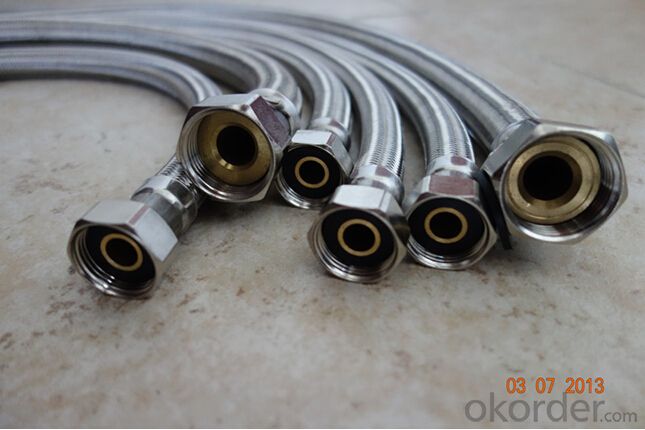
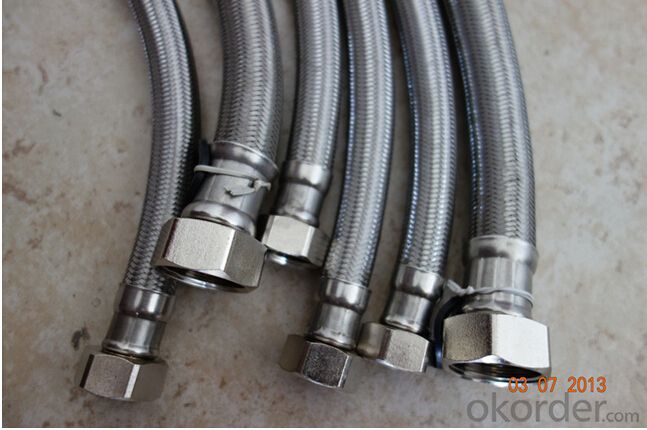
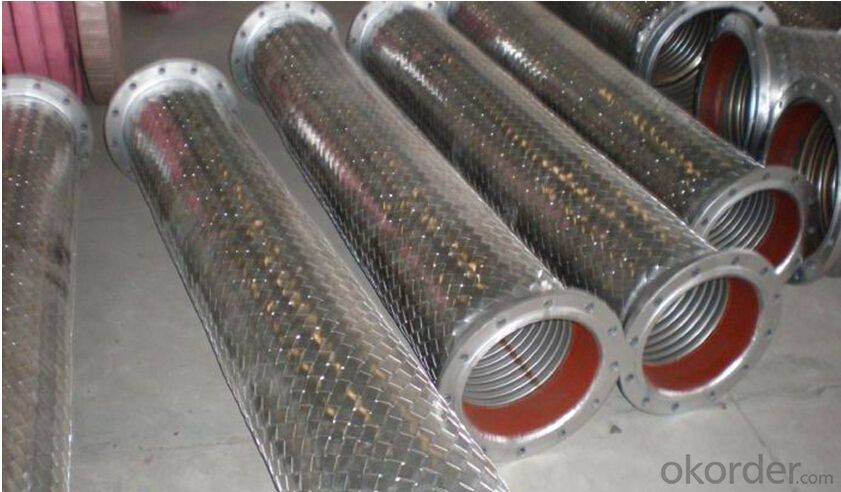
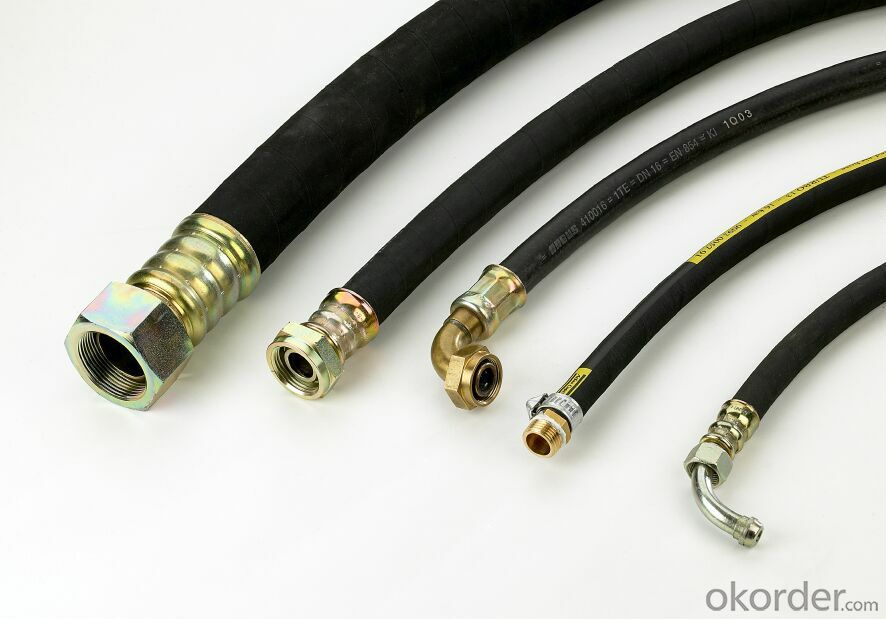
Package of Stainless Steel Braid Hose with Special Treatment:
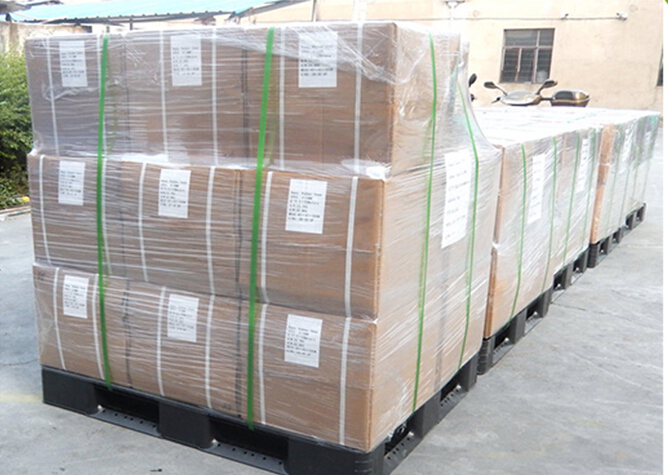
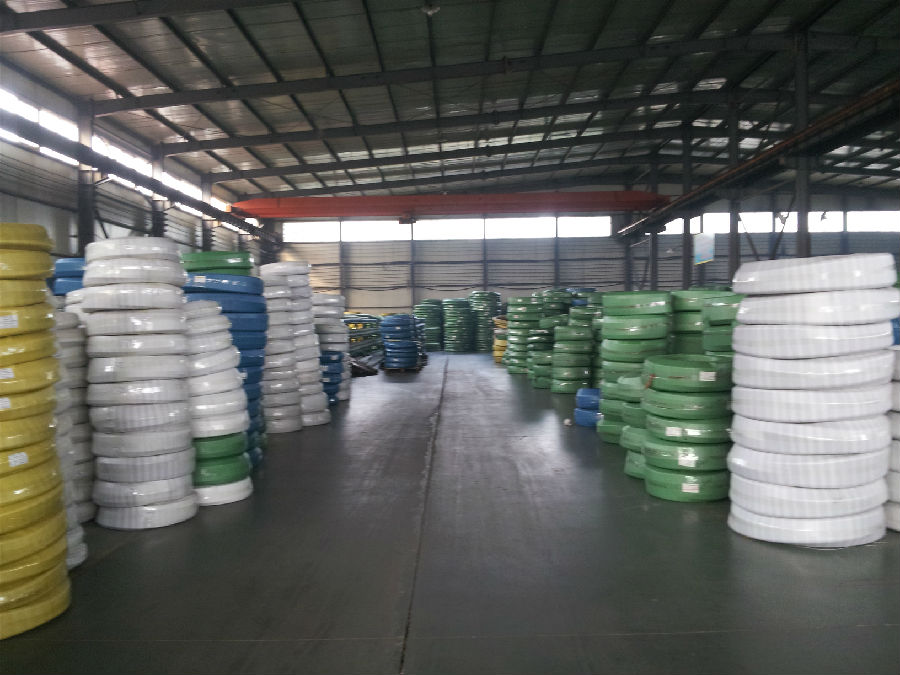
FAQ of Stainless Steel Braid Hose with Special Treatment:
Who we are:
Answer: We CNBM is a Chinese state-owned enterprise ranked 267th among the Global Fortune 500, as the largest building materials company,we have over 300 affiliated companies,and so many production lines and branch office distribute in China.
2. About our quality:
Answer: Every product needs to be quality proved before shipping.
3. About our service:
Answer: We could gurantte that we can reply you in 2 working hours.
- Q:What is the difference between 304J4 and 316J4 stainless steel pipes?
- 304J4 and 316J4 stainless steel pipes exhibit contrasting compositions and properties. In terms of their alloy content, 304J4 stainless steel comprises 18-20% chromium and 8-10% nickel, whereas 316J4 stainless steel consists of 16-18% chromium, 10-14% nickel, and 2-3% molybdenum. The elevated levels of nickel and molybdenum in 316J4 stainless steel pipes contribute to their superior resistance against corrosion compared to 304J4 stainless steel pipes. This characteristic renders 316J4 stainless steel pipes more suitable for applications exposed to harsh environments, including marine and chemical industries. Moreover, the increased molybdenum content in 316J4 stainless steel pipes enhances their ability to withstand pitting and crevice corrosion, which commonly occur in chloride-rich surroundings. Consequently, they are the preferred choice for applications involving exposure to seawater or other corrosive substances. Conversely, 304J4 stainless steel pipes offer a more cost-effective option and are frequently employed in less demanding applications, where corrosion resistance is not a primary concern. They find wide usage in industries such as food processing, appliances, and automotive. In conclusion, the fundamental disparities between 304J4 and 316J4 stainless steel pipes lie in their alloy composition and subsequent corrosion resistance properties. 316J4 stainless steel pipes exhibit heightened corrosion resistance, particularly in chloride-rich environments, making them well-suited for more demanding applications, while 304J4 stainless steel pipes present a cost-effective solution and are commonly utilized in less corrosive environments.
- Q:Can stainless steel pipes be coated?
- Stainless steel pipes have the capability to undergo coating procedures. Coating these pipes serves multiple purposes, such as bolstering their durability, preventing corrosion, providing insulation, and enhancing their aesthetics. There exist diverse options for coating stainless steel pipes, including epoxy coatings, polyurethane coatings, and fusion-bonded epoxy coatings. These coatings are applied to the surface of the stainless steel pipes using various techniques, such as spraying, dipping, or electrophoretic deposition. The selection of the appropriate coating relies on the specific requirements of the application and the environment in which the pipes will be utilized. By coating stainless steel pipes, their lifespan can be significantly extended and their performance can be improved, making them suitable for a wide range of industries including oil and gas, chemical, water treatment, and construction.
- Q:Are stainless steel pipes suitable for automotive exhaust systems?
- Indeed, automotive exhaust systems benefit greatly from the use of stainless steel pipes. This material is highly favored in the industry due to its exceptional resistance to both corrosion and high temperatures. It is capable of enduring the challenging circumstances experienced by exhaust systems, including exposure to moisture, heat, and chemicals. Moreover, stainless steel pipes possess commendable strength and durability, enabling them to withstand the vibrations and pressure fluctuations inherent to these systems. Additionally, these pipes are renowned for their aesthetic appeal, elevating the overall appearance of the vehicle. In conclusion, stainless steel pipes offer a trustworthy and enduring solution for automotive exhaust systems.
- Q:Can stainless steel pipes be used for construction?
- Yes, stainless steel pipes can be used for construction. Stainless steel is a highly durable and corrosion-resistant material, making it suitable for various construction applications. It is commonly used in plumbing systems, water supply lines, and underground piping where corrosion resistance is crucial. Stainless steel pipes are also used in constructing bridges, buildings, and infrastructure projects due to their strength and ability to withstand extreme weather conditions. Additionally, stainless steel's aesthetic appeal and low maintenance make it a preferred choice for architectural designs. Overall, stainless steel pipes are a reliable and long-lasting option for construction purposes.
- Q:Can stainless steel pipes be buried in soil?
- Yes, stainless steel pipes can be buried in soil. Stainless steel is highly resistant to corrosion and can withstand the harsh conditions of being buried underground, making it a suitable choice for various underground applications such as drainage, sewage, and water supply systems.
- Q:Stainless steel tube, also known as why tube?
- The longitudinal section can be divided into equal section tube and variable cross section tubeThe variable section tube has a conical tube, a stepped tube and a periodically cross section pipe, etc.
- Q:Are stainless steel pipes suitable for brewing systems?
- Stainless steel pipes prove to be an exceptional choice for brewing systems. Their remarkable corrosion resistance, hygienic attributes, and durability make stainless steel the most preferred material for brewing equipment. When it comes to brewing, stainless steel pipes demonstrate their superiority by not reacting with the acidic elements present in the process. This ensures that the beer remains free from any undesirable flavors or contaminants. Moreover, stainless steel pipes offer the advantage of easy cleaning and maintenance, making them a perfect fit for the brewing process. In summary, stainless steel pipes guarantee the production of exceptional beer by providing a dependable and long-lasting solution for brewing systems, ensuring high-quality and uncontaminated results.
- Q:What are the different types of stainless steel pipe flanges?
- There are several different types of stainless steel pipe flanges, including slip-on flanges, weld neck flanges, socket weld flanges, threaded flanges, blind flanges, and lap joint flanges. Each type has its own unique design and application, making them suitable for various piping systems and industries.
- Q:Can stainless steel pipes be insulated with polystyrene?
- Yes, stainless steel pipes can be insulated with polystyrene. Polystyrene is a commonly used insulation material due to its excellent thermal insulation properties. It helps prevent heat loss or gain from the pipes and improves energy efficiency. Polystyrene insulation can easily be applied to stainless steel pipes using various methods such as pre-formed insulation jackets, spray foam insulation, or rigid foam board insulation. However, it is important to ensure that the insulation is properly installed and sealed to avoid any potential moisture issues or damage to the pipes.
- Q:Can stainless steel pipes be used for sewage treatment plants?
- Indeed, stainless steel pipes are applicable for sewage treatment plants. The reason lies in stainless steel's ability to endure the harsh and corrosive conditions encountered in such facilities, owing to its corrosion-resistant nature. Its exceptional durability and lengthy lifespan render it a fitting option for conveying sewage and wastewater. Moreover, the smooth surfaces of stainless steel pipes prohibit debris buildup and promote fluid flow. Furthermore, stainless steel exhibits resistance against biological growth, enabling effortless maintenance and cleaning, thus guaranteeing utmost hygiene in sewage treatment plants.
1. Manufacturer Overview |
|
|---|---|
| Location | |
| Year Established | |
| Annual Output Value | |
| Main Markets | |
| Company Certifications | |
2. Manufacturer Certificates |
|
|---|---|
| a) Certification Name | |
| Range | |
| Reference | |
| Validity Period | |
3. Manufacturer Capability |
|
|---|---|
| a)Trade Capacity | |
| Nearest Port | |
| Export Percentage | |
| No.of Employees in Trade Department | |
| Language Spoken: | |
| b)Factory Information | |
| Factory Size: | |
| No. of Production Lines | |
| Contract Manufacturing | |
| Product Price Range | |
Send your message to us
Stainless Steel Braid Hose with Special Treatment
- Loading Port:
- Tianjin
- Payment Terms:
- TT OR LC
- Min Order Qty:
- 1000 pc
- Supply Capability:
- 100000 pc/month
OKorder Service Pledge
OKorder Financial Service
Similar products
New products
Hot products
Hot Searches
Related keywords
